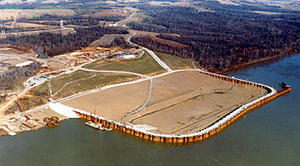InfrastructureAmerica’s outdated waterways, ports hurting economy
Underinvestment in America’s inland waterways cost American businesses approximately $33 billion in 2010. Without a significant increase in investment, that number could increase to $49 billion by 2020. If improvements are not made, 80 percent of American locks will be functionally obsolete by 2020. The extended failure of just one lock can cost agriculture exporters up to $45 million and barge operators as much as $163 million.

Ohio River cofferdam built for Olmstead Lock project // Source: commons.wikimedia.com
Much of America’s maritime infrastructure is dangerously outdated, underinvested in, and often ignored. With the number of ships entering American ports rising, the government will have to get serious about a need to rebuild and improve ports around the nation.
The Economist reports that 70 percent of U.S. imports and 75 percent of its exports go through U.S. sea ports, and the number of ships going through ports around the country is on the rise.
The Panama Canal, which is undergoing expansion, will be able to accommodate 366-meter-long ships with a 15-meter draft, compared with pre-expansion lengths of 294 meters and 12-meter drafts. The expansion will make it easier for Asian ships to reach ports on the east coast and Gulf.
Last year President Barack Obama approved plans to begin the review process of deepening ports in Charleston, Jacksonville, Miami, New York, New Jersey, and Savannah, but the road between approval and completion is long and difficult, and it will take more than funding to get approval.
Kurt Nagle, the head of the American Association of Ports Authorities, told the Economist that in the next five years, “public ports and their private partners expect to invest $9 billion in port infrastructure There… is a shared responsibility, and the federal government, we believe, is not upholding its end of the partnership.”
Currently, the Port of New Orleans, which welcomes ships, barges, trucks, and six Class I freight railways, is going through a refurbishing project that will cost more than $400 million. The port generates more than $17 billion in spending, $800 million in statewide taxes, and 160,000 jobs.
In comparison, America’s transportation department has spent just $357 million on infrastructure improvements at twenty-five ports around the country. According to the American Society of Civil Engineers (ASCE),underinvestment in America’s inland waterways cost American businesses approximately $33 billion in 2010. Without a significant increase in investment, that number could increase to $49 billion by 2020.
Shipping products to and from the United States provides several advantages. Transporting by ship emits less greenhouse gases, uses less fuel, and results in fewer deaths than trains or trucks. A single barge can carry a dry-cargo capacity of sixteen railcars or seventy trucks, and a liquid-cargo capacity of forty-six railcars or 144 trucks.
Senator Lamar Alexander (R-Tennessee) introduced the American Waterworks Act late last year, which would free up money for inland-waterway improvements.
Alexander’s bill would end the requirement that the Inland Waterways Trust Fund — which pays half the costs of lock and dam maintenance and is funded via taxes on commercial users — fund the Olmsted Lock on the Ohio River. That lock was authorized in 1988 with a projected cost of $775 million, but so far has cost over $2 billion and is incomplete.
If improvements are not made, 80 percent of American locks will be functionally obsolete by 2020. The extended failure of just one lock can cost agriculture exporters up to $45 million and barge operators as much as $163 million.
